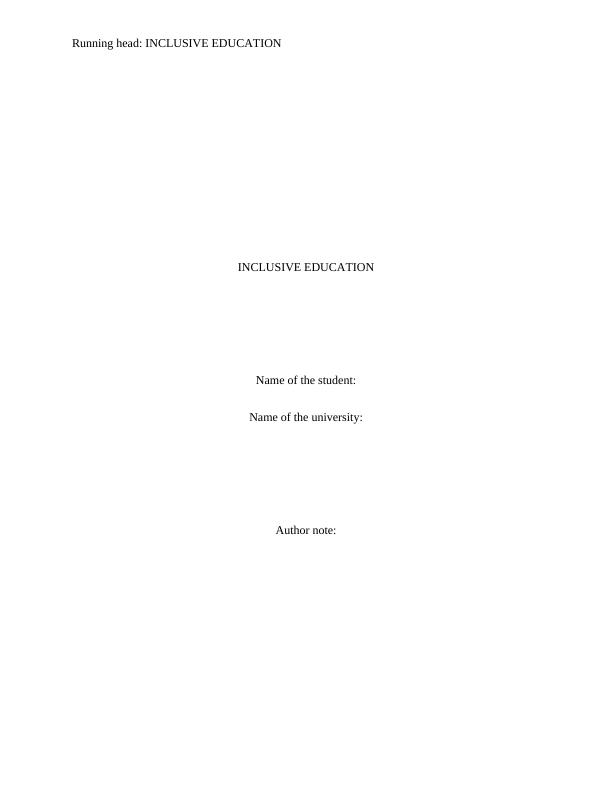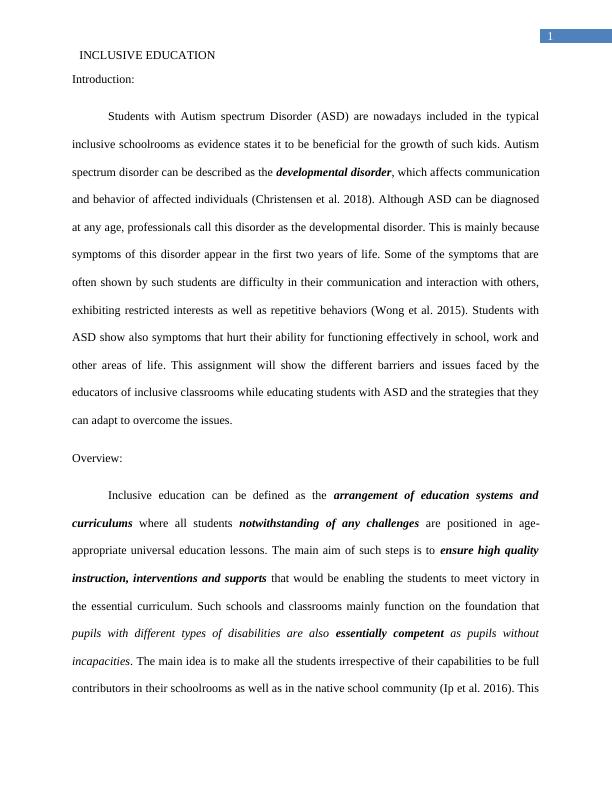Inclusive Education: Barriers, Issues, and Strategies for Students with Autism Spectrum Disorder
Added on 2023-04-21
14 Pages4261 Words80 Views
Running head: INCLUSIVE EDUCATION
INCLUSIVE EDUCATION
Name of the student:
Name of the university:
Author note:
INCLUSIVE EDUCATION
Name of the student:
Name of the university:
Author note:

1
INCLUSIVE EDUCATION
Introduction:
Students with Autism spectrum Disorder (ASD) are nowadays included in the typical
inclusive schoolrooms as evidence states it to be beneficial for the growth of such kids. Autism
spectrum disorder can be described as the developmental disorder, which affects communication
and behavior of affected individuals (Christensen et al. 2018). Although ASD can be diagnosed
at any age, professionals call this disorder as the developmental disorder. This is mainly because
symptoms of this disorder appear in the first two years of life. Some of the symptoms that are
often shown by such students are difficulty in their communication and interaction with others,
exhibiting restricted interests as well as repetitive behaviors (Wong et al. 2015). Students with
ASD show also symptoms that hurt their ability for functioning effectively in school, work and
other areas of life. This assignment will show the different barriers and issues faced by the
educators of inclusive classrooms while educating students with ASD and the strategies that they
can adapt to overcome the issues.
Overview:
Inclusive education can be defined as the arrangement of education systems and
curriculums where all students notwithstanding of any challenges are positioned in age-
appropriate universal education lessons. The main aim of such steps is to ensure high quality
instruction, interventions and supports that would be enabling the students to meet victory in
the essential curriculum. Such schools and classrooms mainly function on the foundation that
pupils with different types of disabilities are also essentially competent as pupils without
incapacities. The main idea is to make all the students irrespective of their capabilities to be full
contributors in their schoolrooms as well as in the native school community (Ip et al. 2016). This
INCLUSIVE EDUCATION
Introduction:
Students with Autism spectrum Disorder (ASD) are nowadays included in the typical
inclusive schoolrooms as evidence states it to be beneficial for the growth of such kids. Autism
spectrum disorder can be described as the developmental disorder, which affects communication
and behavior of affected individuals (Christensen et al. 2018). Although ASD can be diagnosed
at any age, professionals call this disorder as the developmental disorder. This is mainly because
symptoms of this disorder appear in the first two years of life. Some of the symptoms that are
often shown by such students are difficulty in their communication and interaction with others,
exhibiting restricted interests as well as repetitive behaviors (Wong et al. 2015). Students with
ASD show also symptoms that hurt their ability for functioning effectively in school, work and
other areas of life. This assignment will show the different barriers and issues faced by the
educators of inclusive classrooms while educating students with ASD and the strategies that they
can adapt to overcome the issues.
Overview:
Inclusive education can be defined as the arrangement of education systems and
curriculums where all students notwithstanding of any challenges are positioned in age-
appropriate universal education lessons. The main aim of such steps is to ensure high quality
instruction, interventions and supports that would be enabling the students to meet victory in
the essential curriculum. Such schools and classrooms mainly function on the foundation that
pupils with different types of disabilities are also essentially competent as pupils without
incapacities. The main idea is to make all the students irrespective of their capabilities to be full
contributors in their schoolrooms as well as in the native school community (Ip et al. 2016). This

2
INCLUSIVE EDUCATION
form of movement is based on the legislation that all students need to obtain their teaching in the
least preventive environment allowing them to be with peers without incapacities to supreme
degree conceivable. General education is made the first choice for all students.
Benefits for students with disabilities as in case of autism spectrum disorder:
Knowledgeable and skillful teachers mainly carry on fruitful inclusive education
principally through tolerant, understanding as well as addressing numerous student variances
and diversities. This needs to include any form of physical, academic, social, cognitive and
even emotional. Studies are of the opinion that the driving principle of inclusive education for
the students with incapacities like autism spectrum disorder and other pupils without disabilities
is to make them feel greeted and suitably challenged and reinforced in their efforts (Keen et al.
2016). Different researches conducted on the efficiency of the inclusive education have found
out those students with incapacities like autism and other disabilities and short of any disabilities
can study more (Whalon et al. 2015). Research conducted over the previous thirty years have
confirmed the fact that students with incapacities like autism and other disorders have advanced
achievement and enhanced skills over inclusive education (Case et al. 2015). Moreover, peers of
such children who do not face any challenges also benefit from the concept of inclusive
education. For students who suffer from autism spectrum disorder and several similar disorders,
inclusive education help in providing academic gains in literacy like that in cases of reading and
writing and even in math and social studies. They are seen to perform well both in marks and on
uniform tests and even better communiqué skills. Students with ASD also show improvement in
social skills as well as make better friendships with other students (Kasari et al. 2015). Moreover,
a study by Whalon et al. (2015) has also revealed that when students with autism who spend
more time in the inclusive classrooms remain allied with fewer nonattendances and
INCLUSIVE EDUCATION
form of movement is based on the legislation that all students need to obtain their teaching in the
least preventive environment allowing them to be with peers without incapacities to supreme
degree conceivable. General education is made the first choice for all students.
Benefits for students with disabilities as in case of autism spectrum disorder:
Knowledgeable and skillful teachers mainly carry on fruitful inclusive education
principally through tolerant, understanding as well as addressing numerous student variances
and diversities. This needs to include any form of physical, academic, social, cognitive and
even emotional. Studies are of the opinion that the driving principle of inclusive education for
the students with incapacities like autism spectrum disorder and other pupils without disabilities
is to make them feel greeted and suitably challenged and reinforced in their efforts (Keen et al.
2016). Different researches conducted on the efficiency of the inclusive education have found
out those students with incapacities like autism and other disabilities and short of any disabilities
can study more (Whalon et al. 2015). Research conducted over the previous thirty years have
confirmed the fact that students with incapacities like autism and other disorders have advanced
achievement and enhanced skills over inclusive education (Case et al. 2015). Moreover, peers of
such children who do not face any challenges also benefit from the concept of inclusive
education. For students who suffer from autism spectrum disorder and several similar disorders,
inclusive education help in providing academic gains in literacy like that in cases of reading and
writing and even in math and social studies. They are seen to perform well both in marks and on
uniform tests and even better communiqué skills. Students with ASD also show improvement in
social skills as well as make better friendships with other students (Kasari et al. 2015). Moreover,
a study by Whalon et al. (2015) has also revealed that when students with autism who spend
more time in the inclusive classrooms remain allied with fewer nonattendances and

3
INCLUSIVE EDUCATION
recommendations for any forms of troublemaking behaviors. Some of the interview-based
studies have found out that autistic students participating in the inclusive education classes have
better attitudes like those that they have advanced self-concept and they like their institute and
their educators more. Such autistic students are also found to be more motivated around working
and even learning becomes interesting for them (Estes et al. 2015).
Issues affecting inclusive education:
Although there are studies that have put forward the positive outcomes for the pupils with
autism who are contained within inclusive education classroom learning, many others have
argued over its benefits (Szatmari et al. 2015). One of the studies has found out that many
children with autism have behaviors that are incompatible with instructions and therefore they
are seen to master the educational content more slowly (Whalon et al. 2015). Often special
methods are seen to be required to help such children develop their full potential that might not
be included in the general education curriculum in inclusive classrooms.
Studies have shown that when pupils with individual education plans called IEPs for
autism receive an inclusive education, they are found to be deprived of the benefits of the
credentialed special education teachers (Jo et al. 2015). They also cannot be benefitted from the
classroom milieu that have special education supports naturally embedded in it. Much inclusive
education are seen to take place in the chronological age or that of the age level classrooms but it
has been found that many included students suffering from autism are not found to be as close as
that of their academic grade levels as that of their peers without any disabilities. This can be
explained with the help of examples (Gunn et al. 2016). A ten-year-old autism student who can
add might not follow addition “word problems” and might not be benefitted from fifth grade
INCLUSIVE EDUCATION
recommendations for any forms of troublemaking behaviors. Some of the interview-based
studies have found out that autistic students participating in the inclusive education classes have
better attitudes like those that they have advanced self-concept and they like their institute and
their educators more. Such autistic students are also found to be more motivated around working
and even learning becomes interesting for them (Estes et al. 2015).
Issues affecting inclusive education:
Although there are studies that have put forward the positive outcomes for the pupils with
autism who are contained within inclusive education classroom learning, many others have
argued over its benefits (Szatmari et al. 2015). One of the studies has found out that many
children with autism have behaviors that are incompatible with instructions and therefore they
are seen to master the educational content more slowly (Whalon et al. 2015). Often special
methods are seen to be required to help such children develop their full potential that might not
be included in the general education curriculum in inclusive classrooms.
Studies have shown that when pupils with individual education plans called IEPs for
autism receive an inclusive education, they are found to be deprived of the benefits of the
credentialed special education teachers (Jo et al. 2015). They also cannot be benefitted from the
classroom milieu that have special education supports naturally embedded in it. Much inclusive
education are seen to take place in the chronological age or that of the age level classrooms but it
has been found that many included students suffering from autism are not found to be as close as
that of their academic grade levels as that of their peers without any disabilities. This can be
explained with the help of examples (Gunn et al. 2016). A ten-year-old autism student who can
add might not follow addition “word problems” and might not be benefitted from fifth grade

End of preview
Want to access all the pages? Upload your documents or become a member.
Related Documents
Impact of Autism in School: Strategies for Teachers and Parentslg...
|11
|2729
|408
An Introduction to Inclusive Education Name of the University Author Note Introductionlg...
|11
|3025
|224
Group Career Guidance Activity: Autism Spectrum Disorder | Reportlg...
|7
|1379
|12
Management and Care Plan for Autism Spectrum Disorder in Childrenlg...
|10
|2945
|491
Potential Threat of Irish Nation- Autism Spectrum Disorderlg...
|16
|4853
|15
Autism Spectrum Disorder: Symptoms, Diagnosis and Treatmentlg...
|12
|3017
|377
